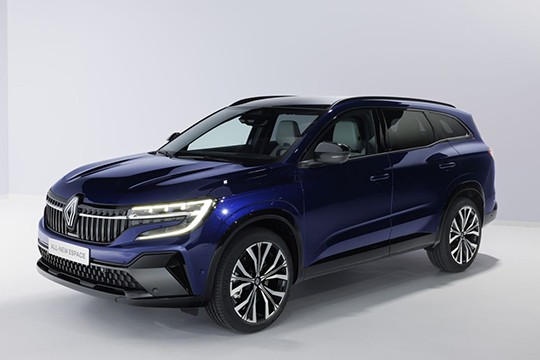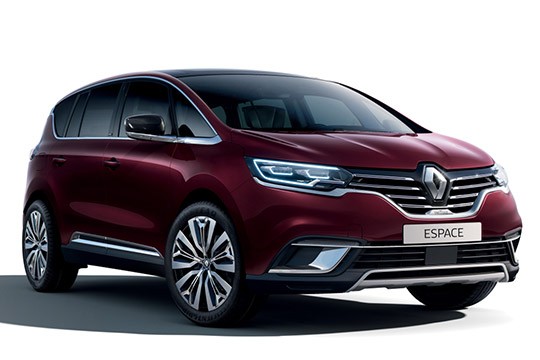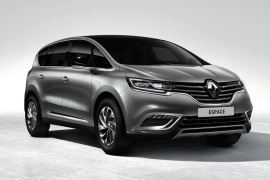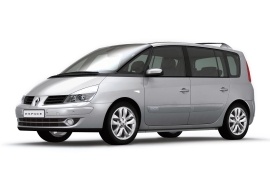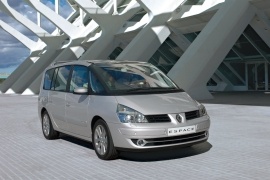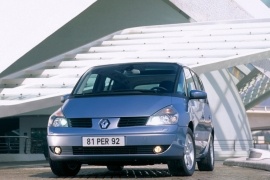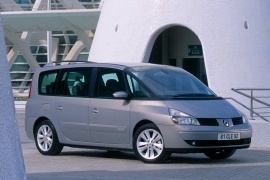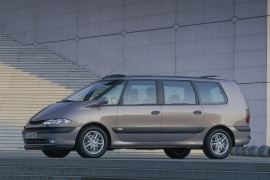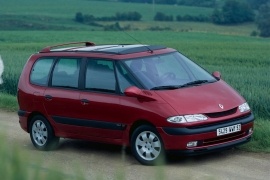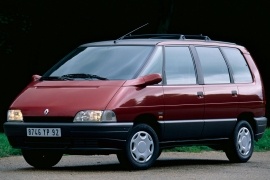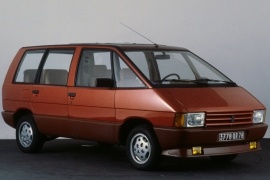RENAULT Espace Models/Series Timeline, Specifications & Photos
First production year: 1985
Engines: Hybrid gasoline, Gasoline, Diesel
Body style: Van
The Espace reached its sixth generation in the Spring of 2023, and Renault placed its bets on a daring evolution by transforming the beloved European MPV into a crossover-style people carrier.
Sharing its CMF-CD platform with the Austral crossover, the new Espace went to the next level and adopted an SUV stance, leaving behind the minivan shape that made it so special on the European market. But the French automaker took all the right steps to create a vehicle that could successfully replace the successful MPV.
While the previous generations of the Espace sported an MPV-like bodywork, the sixth generation was different. It featured a distinct engine compartment and a steeper windshield. The car's front fascia showed the specific, C-shaped, LED daytime running lights that surrounded the outer sides of the headlights. A massive grille with eighteen vertical slats and the broad Renault badge in the middle created a potent image for the vehicle. On the lower side of the bumper, the automaker added a secondary grille flanked by a pair of scoops. The profile revealed a set of enlarged rear fenders that made the SUV look muscular.
Inside, Renault offered the option for five or seven seats, the latter being in a 2-3-2 configuration. The automaker installed a pair of screens on the dashboard. The one fronting the driver was a landscape-mounted, 12.3" TFT display, while the one atop the center stack was a 12" touchscreen mounted vertically. In addition, the automaker offered an option for a 9.3" head-up display.
Among other attractive features of the CMF-CD modular platform was the all-wheel steering system, named 4CONTROL, which helped the car get a tighter turning radius. In addition, it improved handling at higher speeds.
Despite evolving into a niche model that is less mainstream than its predecessors, the Espace has always been an iconic car in the Renault lineup. Its first four generations were family friendly MPVs, while its fifth one, unveiled in 2015, evolved into a high-end crossover with a one-of-a-kind design language. Four years later, Renault decided to the car give a mid-cycle facelift to keep it up to date with the rest of the modernized lineup.
Despite being a crossover-like car, with high ground clearance and a commanding driving position, the refreshed fifth-generation Espace still only powers its front wheels with an assortment of various four-cylinder engines in both gasoline and diesel flavor. The main differences compared to its predecessor revolve around the exterior design, which is now bolder, and the improved available technology features. The front end is all-new and features a redesigned bumper, a new lower front grille and transverse chrome elements to enhance the bold look of the car. The new rear bumper is fitted with a new skid plate to better accentuate the car's crossover looks, while the C-shaped LED matrix adaptive headlamps at the front are not only cooler but also make the car safer at night. The interior has also been revamped, with the floating center console featuring a new closed storage area.
This is one of the best-known MPVs made in Europe: the Renault Espace. Its origins are back in the '80s and the French carmaker became very good in building it for the European roads. In 2014 it showed the fifth generation of its biggest car, which became more like a luxurious MPV crossover than a regular family carrier.
The design is far from what we've seen before in the Renault range. The Espace is built on a new platform developed together with its alliance partners from Nissan. Compared with its predecessors, the new vehicle is available in only one length of 4857 mm (15.9 ft). On the previous generation it used to be available in two wheelbase options. This one is available with 5 or 7 seat options.
Despite the big dimensions, the Espace is available only with four cylinder units. The 160 hp and 200 hp diesel engines have a 2.0-liter displacement, while the gasoline turbocharged unit is a 1.8 liter and offers 225 hp. The transmission for all variants is a 7-speed double-clutch unit.
The handling is eased by an all-wheel-steering system, which allows the rear wheels to steer or counter-steer to ease parking or to handle better at higher speeds.
The interior is part of the high-end luxury segment, with leather upholstery and an infotainment system caller R-LINK.
After four years on the market, the fourth generation of the Espace received an update in 2006 to comply with the Euro 4 emission standards.
Renault introduced the Espace in 1984, and it became the MPV market leader. It was one of the most practical family vehicles thanks to its enormous interior space but kept the length within the mid-size sedan segment. With the facelifted version, Renault improved the car's look, the interior, and the drivetrains. And it did all that in a package that received a five-star rating with flying colors at the Euro NCAP crash-tests.
From the outside, the 2006 Espace featured similarly-shaped headlights as its non-facelifted version, covered with clear lenses. Its redesigned wrapped-around plastic bumper sported a pair of round fog lights on the lower side, flanking a broad black grille stretched from one side to another. The carmaker introduced a new taillights design at the back, which dropped the formerly used round lams and adopted the squared ones, more suitable for the car's overall wedged shape.
The Espace was available with up to seven seats in various configurations. While the third row was not as comfortable as the other two, it still provided plenty of legroom for two children. For the full-option level, named Initiale, the vehicle featured a leather-clad interior, a gigantic panoramic glass roof, and a multi-zone climate control system. The carmaker installed a long and wide dash panel with an instrument cluster installed in the middle. Thus, the rear passengers could read the speed on the digital speedometer.
Renault offered an engine for any needs. It started with a fuel-efficient but sluggish, 1.9-liter turbo-diesel and went up to a potent, 245 hp 3.0-liter V-6 gasoline unit. The carmaker introduced a six-speed automatic gearbox for the 3.0-liter V-6 turbo-diesel starting with the 2006 model year.
Renault introduced the fourth generation of the Espace range in 2002 and, by 2006, it had to improve it to the Euro 4 emission standards, but it did more than that.
The French carmaker offered the Espace in two lengths versions named Espace and Grand Espace. While the former was a practical MPV for families, the latter was often used as a VIP shuttle for hotels, companies, and airports. Renault made it to offer more comfort for the rear passengers. In 2006, along with the engine lineup upgrade, the carmaker added some improvements to the car's exterior and interior.
From the outside, the 2006 Grand Espace featured similarly-shaped headlights as its non-facelifted version, covered with clear lenses. Its redesigned wrapped-around plastic bumper sported a pair of round fog lights on the lower side, flanking a broad black grille stretched from one side to another. The additional length was visible from its sides, especially on the last row of windows, which were longer. The car also sported a longer rear overhang.
Inside, Renault offered the Grand Espace in various configurations and up to eight seats in a 2-3-3 configuration. For the full-option level, named Initiale, the vehicle featured a leather-clad interior, a gigantic panoramic glass roof, and a multi-zone climate control system. The carmaker installed a long and wide dash panel with an instrument cluster installed in the middle. Thus, the rear passengers could read the speed on the digital speedometer.
Under the hood, Renault installed a wide choice of engines, most of them turbo-diesel. Unlike its predecessor, the Grand Espace was available exclusively with a front-wheel-drive.
RENAULT Grand Espace 1.9L dCi 6MT FWD (120 HP)
RENAULT Grand Espace 2.0L dCi 6AT FWD (150 HP)
RENAULT Grand Espace 2.0L dCi 6AT FWD (175 HP)
RENAULT Grand Espace 2.0L dCi 6MT (130 HP)
RENAULT Grand Espace 2.0L dCi 6MT FWD (150 HP)
RENAULT Grand Espace 2.0L dCi 6MT FWD (175 HP)
RENAULT Grand Espace 2.0L Turbo 6MT FWD (120 HP)
RENAULT Grand Espace 2.2L dCi 5AT FWD (140 HP)
Renault continued the success story for the Espace range in 2002 when it introduced the fourth generation of this French MPV that was offered in two length versions.
The Espace was the first successful minivan constructed by a European carmaker, and it was based on a project designed for Matra in the late '70s and rejected by Peugeot for being too audacious. Renault bought it and hit the jackpot. Its main rivals needed almost ten years to catch up with ut. As the Espace entered its fourth generation in 2002, it was already competing in the VIP Shuttle market.
By 2002, most European carmakers had already embraced the new-edge design, and the Espace showed that on its front fascia. The angular-shaped headlights flanked a clear-cut grille that sported the "bird-beak" slat in the middle, like its stablemates Laguna and Clio. On the sides, the Espace featured front-hinged doors, a feature that was available on other brands. Still, the French automaker considered that the cost increase wouldn't be justified.
Inside, the Espace cabin could have been optioned with three rows of seats. However, in that configuration, only a little room was left for the luggage area. The large Renault MPV sported a mid-mounted instrument panel with a green and black LCD on its long and wide dashboard. Thanks to the high-mounted seats, there was plenty of legroom for all the occupants on board, even for those seated in the last row.
Under the hood, Renault installed a choice of two gasoline and three turbo-diesel engines, paired with either a six-speed manual or a five-speed automatic for most of the range. In addition, the 3.0-liter V-6 received a standard six-speed automatic.
Renault introduced the fourth generation of the Espace in 2002 and offered it in two lengths, with seating for six and a larger trunk for the long-wheelbase version.
The Espace was the first successful minivan built by a European carmaker, and it was based on a project made for Matra in the late '70s and rejected by Peugeot for being too bold. Renault bought it and hit the jackpot with it. It took its competitors almost a decade to catch up. In 2002, the Espace reached its fourth generation, and it was already playing in the VIP Shuttle segment, especially in the long-wheelbase version named Grand Espace.
By 2002, the new-edge design was already embraced by most European carmakers, and the Espace showed that on its front fascia. The angular-shaped headlights flanked a clear-cut grille which sported the "bird-beak" slat in the middle, like its stablemates Laguna and Clio. On the sides, the Grand Espace featured a longer rear overhang and a wider third set of windows behind the rear doors. The only downturn for the vehicle was the lack of sliding doors, which Renault considered too expensive.
Inside, the Grand Espace cabin received three rows of seats. It was available either in a 2-3-2 configuration or a 2-2-2 system. The latter left some passage area for the rear-seat passengers. The Espace sported a mid-mounted instrument panel with a green and black LCD on its long and wide dashboard. Thanks to the high-mounted seats, there was plenty of legroom for all the occupants on board, even for those seated in the last row.
Under the hood, Renault installed a choice of two gasoline and three turbo-diesel engines, paired with either a six-speed manual or a five-speed automatic for most of the range. The 3.0-liter V-6 received a standard six-speed automatic.
Renault introduced the third generation of its flagship MPV, the Espace, in 1996, and in 1998, it unveiled the longer version of it, also known as the Grand Espace.
The third generation of this minivan was a revolutionary vehicle compared to its predecessors since it started to attack the VIP market. Moreover, it was already a benchmark in its segment, beating most of its competitors in terms of sales. Also, thanks to this “Grand” version, it could provide room for comfortably sitting seven passengers.
Penned during the bio-design era, the Grand Espace sported organic shapes. Its shaved edges and curved lines made it look friendly to its customers while still providing the necessary requirements to be a spacious vehicle. Unlike its regular Espace sibling, this version sported a longer wheelbase. This led to longer side windows behind the rear doors and wider pillars at the back.
Inside, it provided ample leg- and headroom for all passengers, even in the seven-seat version. The high-mounted front seats featured individual armrests. With its instrument panel placed in the middle of the dashboard, close to the windshield, there was no way that other occupants couldn't clearly read the speedometer. That was displayed with amber numbers on an LCD. In the middle row, there were three individual seats that could've been folded, moved, or reclined. Last but not least, there was room for two additional seats in the back.
Under the hood, Renault installed a choice of gasoline or turbo-diesel engines, ranging from a mundane 98 PS (97 hp) to a healthy 194 PS (188 hp) provided by a 3.0-liter V6.
Renault introduced the third generation of its flagship MPV, the Espace, in late 1996 as a 1997 model year, and it was more than an evolution for the French minivan; it was a revolution.
While the first generation was just a mundane family hauler and the second generation was more of a heavily revised version of that, the third generation was no longer just a people carrier. It was already a benchmark in the European MPV segment. Moreover, it was also available as a luxury vehicle. It became a competitor for premium sedans in terms of comfort and amenities.
Created during the peak times of the bio-design trend, the Espace sported organic shapes and lines. Its curved lines and soft edges made it look friendly to its customers. Even though its front side was short and sloped, and the broad windshield followed the same line as the hood, it didn't look like a utility vehicle anymore. In addition, the aerodynamically profiled door mirrors were something that most of its competitors still needed to provide. The car's gigantic tailgate was stretched to the max but featured cut-outs for the taillights.
Inside, it was roomier than any other Renault vehicle. It provided ample leg- and headroom for all passengers, especially in the five-seat version. The high-mounted front seats featured individual armrests. With its instrument panel placed in the middle of the dashboard, close to the windshield, there was no way that other occupants couldn't clearly read the speedometer. That was displayed with amber numbers on an LCD. In the back, there were three individual seats that could've been folded, moved, or reclined. They also provided vast room for their passengers.
Under the hood, Renault installed a choice of gasoline or turbo-diesel engines, ranging from a mundane 98 PS (97 hp) to a healthy 194 PS (188 hp) provided by a 3.0-liter V6.
Renault launched the second generation of the Espace MPV in 1991 and proved that it was the car to beat in that segment.
Even though in other segments, Renault was not a tough competitor, the Espace was the best European minivan since its production started in 1984. With the 1991 model, the French automaker really killed its competition and, furthermore, made the American minivans look outdated and outplaced in Europe.
With a design that resembled a TGV's engine (French High-speed trains), the raked front fascia formed an almost continuous curved line between the bumper and the car's roof. The small rectangular headlights looked like they were carried over from a sedan. On the profile, the bodywork showed an almost equal area of glass and metal parts, while the back showed a vertical drop for the tailgate.
Inside, due to the vast glass area, the Espace offered a fish-tank experience to its customers. Besides the thicker D-pillars, there were almost no real obstacles to block the passengers' view. In addition, the driver also had an excellent view of the road thanks to the low-mounted dashboard and high-mounted seats. There was plenty of legroom and headroom for the first and second rows of seats, while the third row was good enough for teenagers, not just for children.
Under the hood, Renault offered a wide choice of engines, both gasoline, and a fuel-efficient turbo-diesel.
The 1984 Renault Espace was the car that started the MPV revolution in Europe. It was conceived as a vehicle fit for families, for a taxi, for shuttle services, and leisure.
A series of events made the Espace to be launched as a Renault, even if it wasn't designed to be made under that name. It was designed by a British designer for Chrysler and developed by the French coachbuilder Matra for Simca. Simca was a member of Chrysler Group along with Talbot. The financial problems led Chrysler to sell Simca to Peugeot, who didn't want to produce the car. Matra, after it invested in the project, sold the concept to Renault who, in the end, launched the car in July 1984 and it was a huge success.
The design was unique on the market. Its single-box design with a sloped front and big windows all-around were unusual. The car was higher than the regular cars and that gave the occupants a better view and an increased safety feeling.
The biggest advantage of the vehicle was the interior, which featured up to seven seats. Apart from the driver's seat, all the others could have been removed. The front seats could have been swiveled with 180 degrees so it could form a meeting room. Or, if the car was fitted with the option for a table, a dining room. Not to mention that the second and last row of seats could have been reclined and form a king-size bed.
The platform was built for longitudinal engines. Renault installed a 2.0-liter and 2.2-liter gasoline units in the beginning. A 2.1-liter turbo diesel was added later. It was mated to a standard 5-speed manual.
